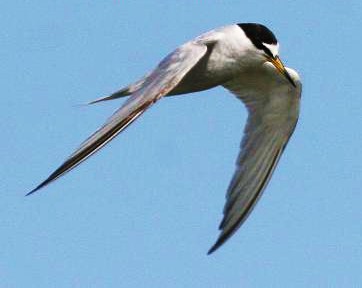Sternula lorata
 |
| (Photo from Internet Bird Collection) |
Common name:
Peruvian tern (en); trinta-réis-do-Peru (pt); sterne du Pérou (fr); charrancito peruano (es); Peruseeschwalbe (de)
Taxonomy:
Order Charadriiformes
Family Sternidae
Range:
This South American species is restricted to the Humboldt Current zone from northern Peru to the Peninsula of Mejillones in Chile.
Size:
These birds are 22-24 cm long and weighs 45-60 g.
Habitat:
They breed either on broad sandy beaches and dunes associated with wetlands, or in desert plains, always within 3 km of the coast. They generally forage in shallow inshore areas, but occasionally seen 10-70 km offshore, and will also forage in coastal wetlands.
Diet:
They hunt fish by darting into the water, mostly taking anchovies Engraulis ringens, South Pacific sauris Scomberesox saurus, Peruvian silversides Odonthestes regia and mote sculpins Normanychtis crockeri.
Breeding:
Peruvian terns breed in October-January. They nest in small groups, with 3-25 pairs in loose aggregation. Each pair nests in a shallow depression on bare ground, where the female lays 1-2 buff-coloured eggs. The eggs are incubated by both parents for 22-23 days and the chicks leave the nest within 2 days after hatching. The parents will protect the chicks from predators until they fledge, 21-24 days after hatching.
Conservation:
IUCN status – EN (Endangered)
This species has a relatively small breeding range and a global population estimated at just 1.000-2.500 individuals. The population is suspected to be declining on the basis of continued destruction and degradation of its breeding habitat, disappearance of breeding colonies in the last 30 years and population decline in some localities. This species was gravely affected by the 1972 collapse of anchoveta Engraulis sp. stocks, but currently the main threat is the destruction of breeding habitat through the building of shanty towns, summer homes, road constructions and off-road recreational driving. Other threats include wetland pollution and water use for irrigation, conversion of desert plains into agricultural land, management of wetland water levels and oil exploration near breeding areas.







